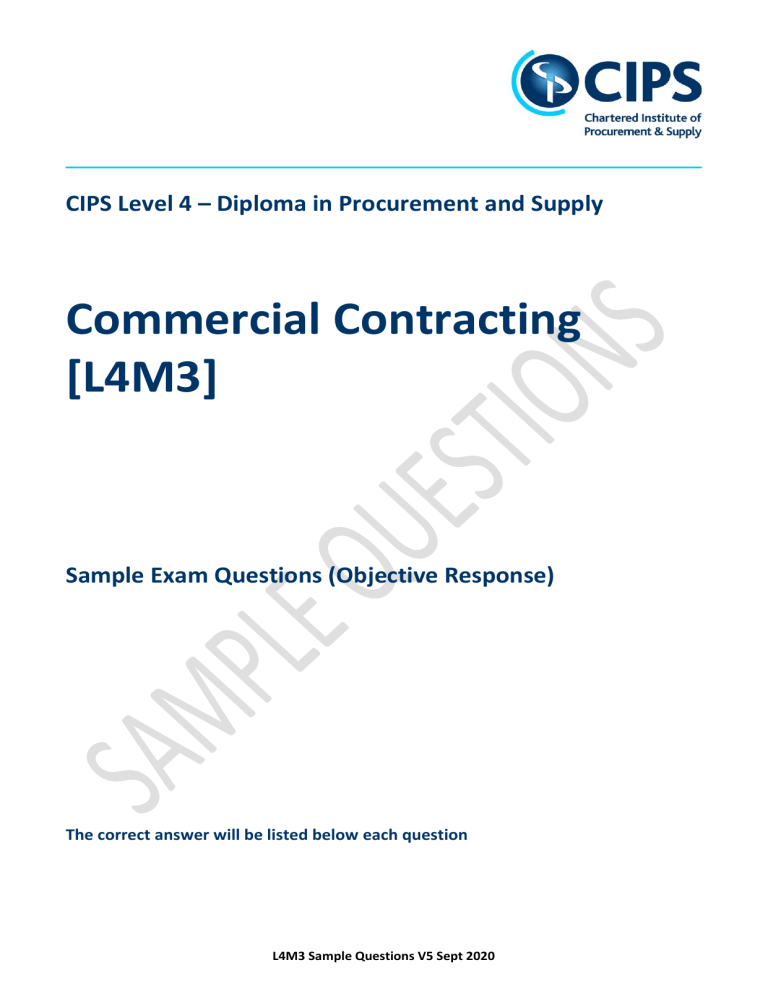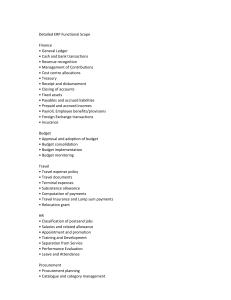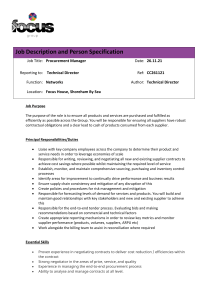
CIPS Level 4 – Diploma in Procurement and Supply Commercial Contracting [L4M3] Sample Exam Questions (Objective Response) The correct answer will be listed below each question L4M3 Sample Questions V5 Sept 2020 Q1. Which ONE of the following is a provision in a contract under which one party commits to compensate the other for any harm or loss arising out of the contract? a. Indemnity b. Intellectual property c. Exclusion clause d. Warranty LO: 3 AC: 3.2 Correct answer: A Q2. Which of the following are likely to feature within a request for quotation (RFQ)? 1. Delivery terms are fixed 2. Suppliers are not pre-qualified 3. Suppliers have been pre-qualified 4. Quality must be assessed a. 1 and 2 only b. 2 and 3 only c. 1 and 3 only d. 2 and 4 only LO: 1 AC: 1.1 Correct answer: C Learning outcome (LO) Assessment criteria (AC) The correct answer is listed below each question Q3. A procurement manager has negotiated a firm fixed price throughout a contract with a duration of two years. Was this the right thing to do? a. No, because even with these contracts the pricing can change b. No, because this is an unfair term and therefore it is not legally binding c. Yes, because this has provided certainty and so it is an aid to budgeting d. Yes, because this type of pricing will always be better than a spot price LO: 3 AC: 3.3 Correct answer: C Q4. Ace Group is seeking to encourage one of its key suppliers to improve its contract delivery performance. Ace Group wants to encourage the supplier to identify cost savings and ways to enhance quality. Which of the following would help? a. Gainshare b. Using industry indices c. Penalty clauses d. Service credits LO: 3 AC: 3.3 Correct answer: A Q5. When is the best time for the buyer's express terms to be provided to a supplier in a competitive bidding process with negotiation? a. At the contract commencement meeting b. When the negotiation is nearing completion c. With the contract award notification d. As part of the invitation to tender LO: 3 AC: 3.1 Correct answer: D Learning outcome (LO) Assessment criteria (AC) The correct answer is listed below each question Q6. Which ONE of the following is often used with service level agreements (SLAs), as part of performance management, to encourage a supplier to meet a buyer's requirements? a. Service guarantees b. Service credits c. Service warranties d. Service penalties LO: 2 AC: 2.2 Correct answer: B Q7. A public sector organisation maintains a large and diverse property estate comprising of more than 100 buildings in multiple locations around the country. To maintain this property estate, which of the following will be the most effective arrangement between the organisation and its suppliers? a. Framework agreements b. One off purchases c. Spot transactions d. Purchase orders LO: 1 AC: 1.3 Correct answer: A Learning outcome (LO) Assessment criteria (AC) The correct answer is listed below each question Q8. A large manufacturing group is going through a period of investment under which a number of its facilities will close on a short-term basis for re-fit and for upgrade works to be undertaken. The chief procurement officer (CPO) is concerned about the impact on the organisation's ability to meet customer orders should any of the work carried out by suppliers overrun. In respect of this particular concern, the CPO should consider using which of the following contractual terms with these suppliers? a. Insurance b. Force majeure c. Liquidated damages d. Jurisdiction LO: 3 AC: 3.2 Correct answer: C Q9. Which of the following will typically be included with an invitation to tender (ITT)? Select the THREE that apply. a. Specification b. Purchase order c. Terms and conditions d. Requisition e. Performance measures f. Mandate LO: 1 AC: 1.1 Correct answer: A, C & E Learning outcome (LO) Assessment criteria (AC) The correct answer is listed below each question Q10. Under general legal principles of contract formation, which of the following will always automatically result in the termination of an offer? Select the TWO that apply. a. Acceptance b. Negotiation c. Clarification d. Non-disclosure e. Revocation LO: 1 AC: 1.2 Correct answer: A & E Q11. Which of the following enables bidders to present solutions that the buyer might not have considered when responding to an invitation to tender (ITT)? a. Technical specification b. Input specification c. Performance specification d. Conformance specification LO: 1 AC: 1.1 Correct answer: C Learning outcome (LO) Assessment criteria (AC) The correct answer is listed below each question Q12. The concept of the 'battle of the forms' relates mostly to which of the following? a. The buyer's specification b. Terms and conditions that apply c. The invitation to tender d. Key performance indicators LO: 1 AC: 1.2 Correct answer: B Q13. Westhire Authority (WA) is a large public sector organisation. It covers a vast geographic area and has a considerable property estate. It uses a number of suppliers to carry out routine and, on occasions, emergency repairs and other maintenance on both the grounds and the buildings of its property estate. Which type of arrangement would WA have in place for these requirements? a. Framework agreement b. Sole supply agreement c. Dual-sourcing agreement d. Contingency agreement LO: 1 AC: 1.3 Correct answer: A Learning outcome (LO) Assessment criteria (AC) The correct answer is listed below each question Q14. Global Energy Efficiency Group (GEEG) is a major manufacturing organisation. It has committed to invest significantly in new turbines but is unsure about which products are available and how these might change in the future due to new technology advances. What should GEEG do as a priority to help draft a specification? a. Arrange a meeting with Finance b. Talk to its incumbent supplier c. Use recognised international standards d. Undertake market engagement LO: 2 AC: 2.1 Correct answer: D Q15. A major retail organisation has come under pressure from consumers to place more emphasis on social value when sourcing its products. It should prioritise which of the following criteria when developing specifications and selecting suppliers? 1. 2. 3. 4. Reducing product costs Supporting local communities Improving working conditions Increasing sales revenues a. 1 and 2 only b. 2 and 3 only c. 3 and 4 only d. 1 and 3 only LO: 2 AC: 2.1 Correct answer: B Learning outcome (LO) Assessment criteria (AC) The correct answer is listed below each question Q16. Which of the following are characteristics of liquidated damages within a contract? 1. 2. 3. 4. Apply excessive penalties for all breaches Explain the process for dispute management Set out the circumstances when they apply State the financial implications for the supplier a. 1 and 2 only b. 2 and 3 only c. 3 and 4 only d. 1 and 3 only LO: 3 AC: 3.2 Correct answer: C Q17. Express terms apply in all contracts through the buyer's and supplier's statutory rights. Is this statement TRUE? a. Yes, in most contracts statutory rights are expressly stated b. No, express terms are specifically agreed between the parties c. Yes, all terms must be expressly stated in the contract to be legally binding d. No, if it is a verbal agreement no terms will apply at all LO: 3 AC: 3.1 Correct answer: B Learning outcome (LO) Assessment criteria (AC) The correct answer is listed below each question Q18. Model form contracts are popular because they offer additional protections to suppliers. Is this statement correct? a. Yes, in industries that use model contracts they protect a buyer from all supplier conditions b. No, they are popular because it is a legal requirement to use them if available in that industry sector c. Yes, in those industries that use them model contracts considerably limit supplier liability d. No, they are popular because they are widely accepted and understood in industries that use them LO: 3 AC: 3.1 Correct answer: D Q19. Which of the following arrangements permit the supplier to charge more, in certain circumstances, over the term of the contract? Select the TWO that apply. a. Pricing schedules b. Fixed priced c. Bills of quantity d. Indexation e. Price adjustment formula LO: 3 AC: 3.3 Correct answer: D & E Learning outcome (LO) Assessment criteria (AC) The correct answer is listed below each question Q20. Which of the following are necessary conditions for misrepresentation within a commercial agreement? Select the THREE that apply. a. The statement must be made after the contract is created b. The statement must relate to fact c. The statement must be false d. The statement must be made by a contracting party e. The statement must be made in public f. The statement must be fraudulent LO: 1 AC: 1.2 Correct answer: B, C & D Learning outcome (LO) Assessment criteria (AC) The correct answer is listed below each question




